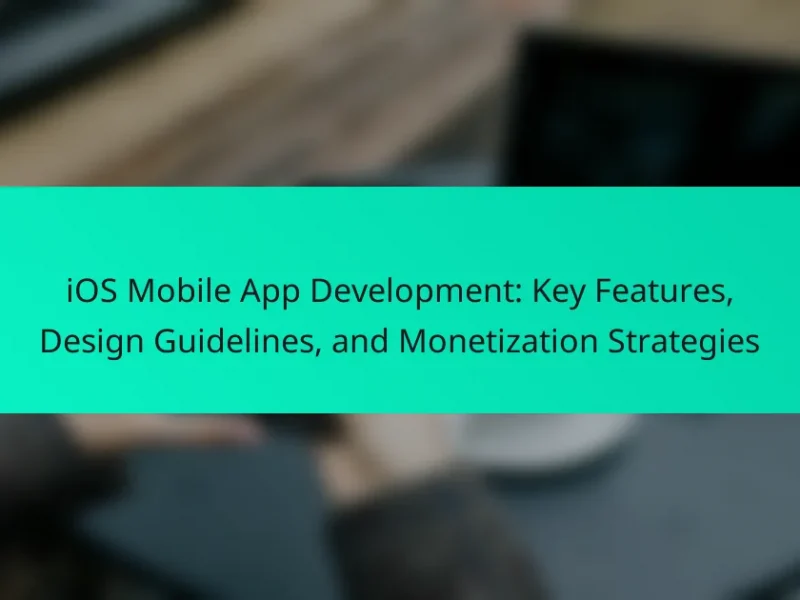Native mobile app development involves creating applications tailored for specific mobile operating systems, utilizing platform-specific programming languages and tools such as Swift or Objective-C for iOS and Java or Kotlin for Android. This development approach maximizes device capabilities, resulting in superior performance and user experiences compared to hybrid or web applications. Native apps dominate mobile app usage, accounting for approximately 90% of engagement, highlighting their effectiveness. The article will explore the advantages and disadvantages of native mobile app development, as well as the programming languages commonly employed in this process.

What is Native Mobile App Development?
Native mobile app development refers to the process of creating applications specifically for a particular mobile operating system. This approach utilizes platform-specific programming languages and tools. For example, iOS apps are typically developed using Swift or Objective-C. Android apps are commonly built with Java or Kotlin.
Native apps are designed to leverage the full capabilities of the device. They provide better performance and a more seamless user experience compared to hybrid or web apps. According to a report by Statista, native apps account for approximately 90% of mobile app usage. This indicates their popularity and effectiveness in engaging users.
How does Native Mobile App Development differ from other types of app development?
Native mobile app development creates applications specifically for one platform, such as iOS or Android. This approach allows developers to utilize platform-specific programming languages like Swift for iOS or Kotlin for Android. It results in better performance and user experience compared to cross-platform development. Native apps have direct access to device features like GPS and camera, enhancing functionality.
In contrast, other types of app development, like hybrid or web apps, rely on a single codebase for multiple platforms. Hybrid apps use web technologies wrapped in a native shell, which can lead to performance limitations. Web apps run in browsers and do not access device features as seamlessly.
Statistically, native apps tend to have higher user satisfaction ratings and lower crash rates. According to a 2021 study by Statista, native apps account for over 90% of mobile app revenue. This data supports the notion that native development provides significant advantages over other methods.
What are the key characteristics of Native Mobile Apps?
Native mobile apps are applications developed specifically for a particular operating system, such as iOS or Android. They provide optimal performance and user experience by utilizing device-specific features. Native apps have access to the full range of device capabilities, including camera, GPS, and push notifications. They are typically written in languages like Swift for iOS and Kotlin for Android. Native apps can operate offline, enhancing usability in areas with poor connectivity. They are distributed through official app stores, ensuring easier updates and security checks. User interfaces of native apps are designed to align with platform-specific guidelines, promoting familiarity for users. This adherence to guidelines often results in higher user satisfaction and engagement.
Why choose Native Mobile App Development over cross-platform options?
Native mobile app development offers superior performance and user experience compared to cross-platform options. Native apps are built specifically for one platform, utilizing the device’s hardware and software capabilities fully. This leads to faster load times and smoother interactions. Native development allows for better access to platform-specific features, such as camera, GPS, and push notifications. According to a study by Statista, native apps have higher user engagement and retention rates than cross-platform apps. Furthermore, native apps often receive faster updates and access to new features released by the operating system. This ensures that users benefit from the latest advancements and improvements. Overall, native mobile app development provides a more tailored and efficient solution for app creation.
What are the main benefits of Native Mobile App Development?
Native mobile app development offers superior performance and user experience. Native apps are built specifically for a platform, ensuring optimal functionality. They leverage device-specific hardware and software features effectively. This leads to faster load times and smoother interactions.
Additionally, native apps provide seamless integration with device features like GPS, camera, and notifications. This enhances user engagement and satisfaction. According to Statista, native apps have higher user retention rates compared to hybrid apps.
Moreover, native development allows for better security. Developers can utilize platform-specific security features, minimizing vulnerabilities. This is particularly important for apps handling sensitive data.
Overall, native mobile app development results in high-quality applications tailored for specific operating systems.
How does performance compare to other app development methods?
Native mobile app development typically offers superior performance compared to other app development methods. Native apps are built specifically for a particular platform, such as iOS or Android. This allows them to take full advantage of device hardware and software capabilities. As a result, native apps often exhibit faster load times and smoother animations.
For instance, a study by Statista shows that native apps have a 20-30% faster response time than hybrid apps. Furthermore, native development allows access to the latest APIs and features, enhancing overall performance. In contrast, cross-platform solutions may face limitations due to their reliance on abstraction layers. These layers can introduce latency and reduce responsiveness.
Overall, native mobile app development stands out for its performance efficiency, making it the preferred choice for resource-intensive applications.
What user experience advantages do Native Apps provide?
Native apps provide superior user experience advantages due to their optimized performance and seamless integration with device features. They offer faster load times compared to web apps, enhancing user satisfaction. Native apps also ensure a more responsive interface, which is crucial for user engagement. They can utilize device capabilities like GPS, camera, and notifications effectively. This leads to more personalized and interactive experiences. Furthermore, native apps adhere to platform-specific design guidelines, resulting in intuitive navigation. According to a study by Google, users spend 90% of their mobile time on apps, highlighting the importance of native app performance.
What challenges are associated with Native Mobile App Development?
Native mobile app development faces several challenges. One major challenge is the high cost of development. Native apps require separate codebases for iOS and Android, increasing time and resources. Another challenge is the need for specialized skills. Developers must be proficient in platform-specific languages like Swift for iOS and Kotlin for Android.
Additionally, maintaining and updating multiple versions of the app can be complex. This can lead to inconsistencies in user experience across platforms. Fragmentation of devices is another issue. Developers must ensure compatibility with various screen sizes and operating system versions.
Lastly, the approval process for app stores can be time-consuming. Each platform has its own guidelines, which can delay the launch. These challenges highlight the complexities involved in native mobile app development.
What are the common limitations of Native Mobile Apps?
Common limitations of native mobile apps include high development costs and time. Developing for multiple platforms requires separate codebases. This leads to increased maintenance efforts. Native apps also have limited cross-platform compatibility. They may not utilize device features uniformly across platforms. Additionally, native apps can face longer approval times in app stores. Users must download and install updates, which can hinder engagement. Lastly, native apps consume more device storage compared to web apps.
How can development costs impact project decisions?
Development costs significantly influence project decisions. High development costs can lead to project cancellations or scope reductions. Budget constraints often dictate the technology stack and features included. Teams may prioritize essential functionalities over luxury features. This prioritization can affect user experience and market competitiveness. Additionally, cost overruns can result in delays and resource reallocations. Companies may also seek alternative funding or partnerships to mitigate costs. Ultimately, development costs directly shape project feasibility and strategic direction.
What programming languages are used in Native Mobile App Development?
Native mobile app development primarily utilizes Swift and Kotlin. Swift is the main programming language for iOS applications. Kotlin serves as the preferred language for Android app development. Both languages offer modern features and improved performance. Swift was introduced by Apple in 2014. Kotlin was officially supported by Google for Android development in 2017. These languages enhance developer productivity and app efficiency. They are designed to work seamlessly with their respective platforms.
What are the primary languages for iOS app development?
The primary languages for iOS app development are Swift and Objective-C. Swift is a modern programming language introduced by Apple in 2014. It is designed for safety, performance, and expressiveness. Objective-C is an older language that has been used for iOS development since the platform’s inception. Both languages are supported by Apple’s development environment, Xcode. Swift is increasingly preferred due to its simplicity and efficiency. Objective-C continues to be relevant for maintaining older applications. According to Apple’s documentation, Swift is the recommended language for new iOS projects.
Which languages are commonly used for Android app development?
Java and Kotlin are commonly used for Android app development. Java has been the traditional language for Android since its inception. It offers a robust framework and extensive libraries. Kotlin, introduced in 2017, is now the preferred language for many developers. It provides modern features and improved syntax. Both languages are officially supported by Google. According to the Android Developers website, Kotlin is now recommended for new Android projects. This shift reflects Kotlin’s growing popularity and efficiency in app development.
How can developers choose the right programming language for their Native App?
Developers can choose the right programming language for their native app by assessing project requirements, platform compatibility, and team expertise. The primary platforms are iOS and Android, which typically require Swift or Objective-C for iOS and Kotlin or Java for Android. Developers should evaluate the app’s performance needs, user experience, and available libraries. Additionally, considering the future maintenance and scalability of the app is crucial.
Research shows that Swift is preferred for iOS development due to its efficiency and safety features. For Android, Kotlin is officially supported by Google and offers modern programming capabilities. Ultimately, the choice should align with the specific goals of the app and the skills of the development team.
What factors should influence the choice of programming language?
The choice of programming language should be influenced by project requirements, performance needs, and developer expertise. Project requirements dictate the language’s suitability for specific tasks. Performance needs determine how efficiently the language can handle resource-intensive operations. Developer expertise ensures that the team can effectively implement and maintain the code. Additionally, community support and available libraries can enhance development speed and ease of troubleshooting. Compatibility with target platforms is also crucial for ensuring seamless app functionality. Finally, long-term maintenance considerations can influence language choice, as some languages may offer better support for updates and scalability.
How do team skills and project requirements affect language selection?
Team skills and project requirements significantly influence language selection in mobile app development. A team’s proficiency in specific programming languages determines which languages can be effectively utilized. For instance, if a team excels in Swift, they are likely to choose it for iOS development.
Project requirements, such as performance needs and platform compatibility, also guide language choices. High-performance applications may necessitate languages like Kotlin or Swift, which are optimized for mobile platforms. Additionally, if a project demands cross-platform capabilities, languages like JavaScript or Dart become essential.
The alignment of team skills with project needs ensures efficient development processes. According to a survey by Stack Overflow, developers often select languages based on their familiarity and the project’s technical requirements. This ensures that the development team can deliver quality results within deadlines.
What are best practices for successful Native Mobile App Development?
Successful native mobile app development requires a combination of best practices. First, thorough market research is essential to understand user needs and competition. This ensures the app addresses real problems and stands out. Second, defining clear objectives and goals helps guide the development process. These objectives should be measurable to track progress.
Third, employing a user-centered design approach enhances usability. Creating wireframes and prototypes allows for early user feedback. Fourth, selecting the right technology stack is crucial. The choice of programming languages and frameworks should align with app requirements and target platforms.
Fifth, implementing agile development methodologies fosters flexibility. This approach allows for iterative improvements based on user feedback and testing. Sixth, rigorous testing throughout the development cycle is vital. This includes functional, performance, and security testing to ensure a robust final product.
Seventh, optimizing for performance improves user experience. Efficient coding and resource management can significantly reduce load times. Lastly, planning for post-launch support and updates is important. Continuous monitoring and user engagement help maintain app relevance and satisfaction. Following these best practices increases the likelihood of a successful native mobile app.
How can developers ensure optimal performance and user experience?
Developers can ensure optimal performance and user experience by implementing efficient coding practices. They should minimize resource usage and optimize algorithms for speed. Using asynchronous programming can enhance responsiveness. Developers must also test applications on multiple devices to ensure compatibility. Regular updates and bug fixes are essential for maintaining performance. Utilizing profiling tools helps identify bottlenecks in the application. According to a study by Google, apps that load within 3 seconds have a significantly higher user retention rate. This highlights the importance of performance optimization in user experience.
What tools and resources can facilitate the development process?
Development processes can be facilitated by various tools and resources. Integrated Development Environments (IDEs) like Android Studio and Xcode streamline coding and debugging. Version control systems such as Git help manage code changes efficiently. Project management tools like Jira and Trello enhance team collaboration and task tracking. Frameworks such as React Native and Flutter enable cross-platform development. Additionally, libraries and APIs provide pre-built functionalities to accelerate development. Documentation resources like Stack Overflow and official language documentation offer guidance and troubleshooting assistance. These tools collectively improve workflow, enhance productivity, and reduce development time.
Native mobile app development refers to the creation of applications tailored specifically for individual mobile operating systems, utilizing platform-specific programming languages such as Swift for iOS and Kotlin for Android. This approach offers superior performance, user experience, and access to device features compared to hybrid or web apps, leading to higher user engagement and satisfaction. The article will explore the key characteristics, benefits, and challenges of native mobile app development, as well as the programming languages used and best practices for successful implementation. Additionally, it will address the impact of development costs and team skills on language selection, ensuring a comprehensive understanding of the topic.


